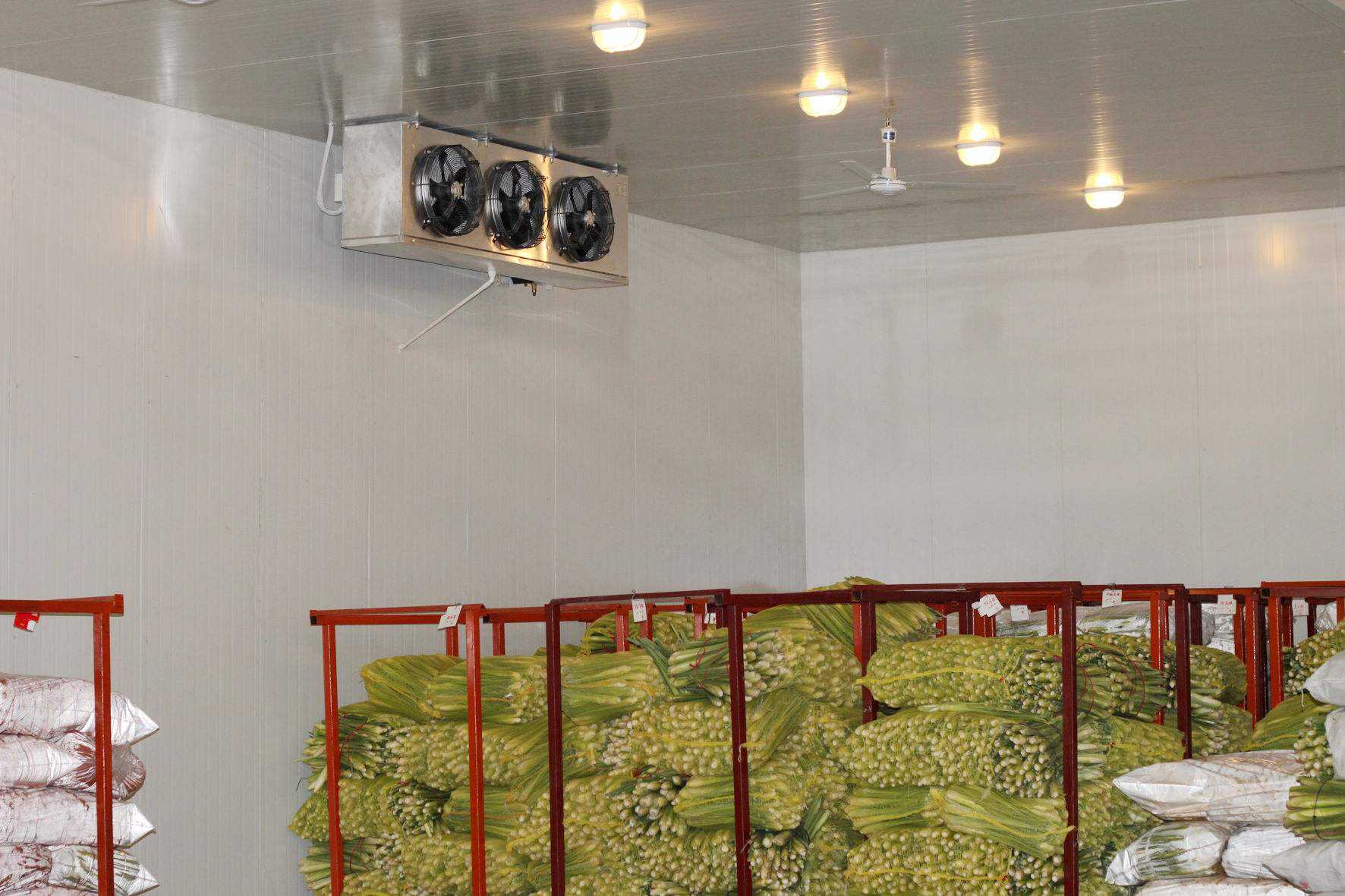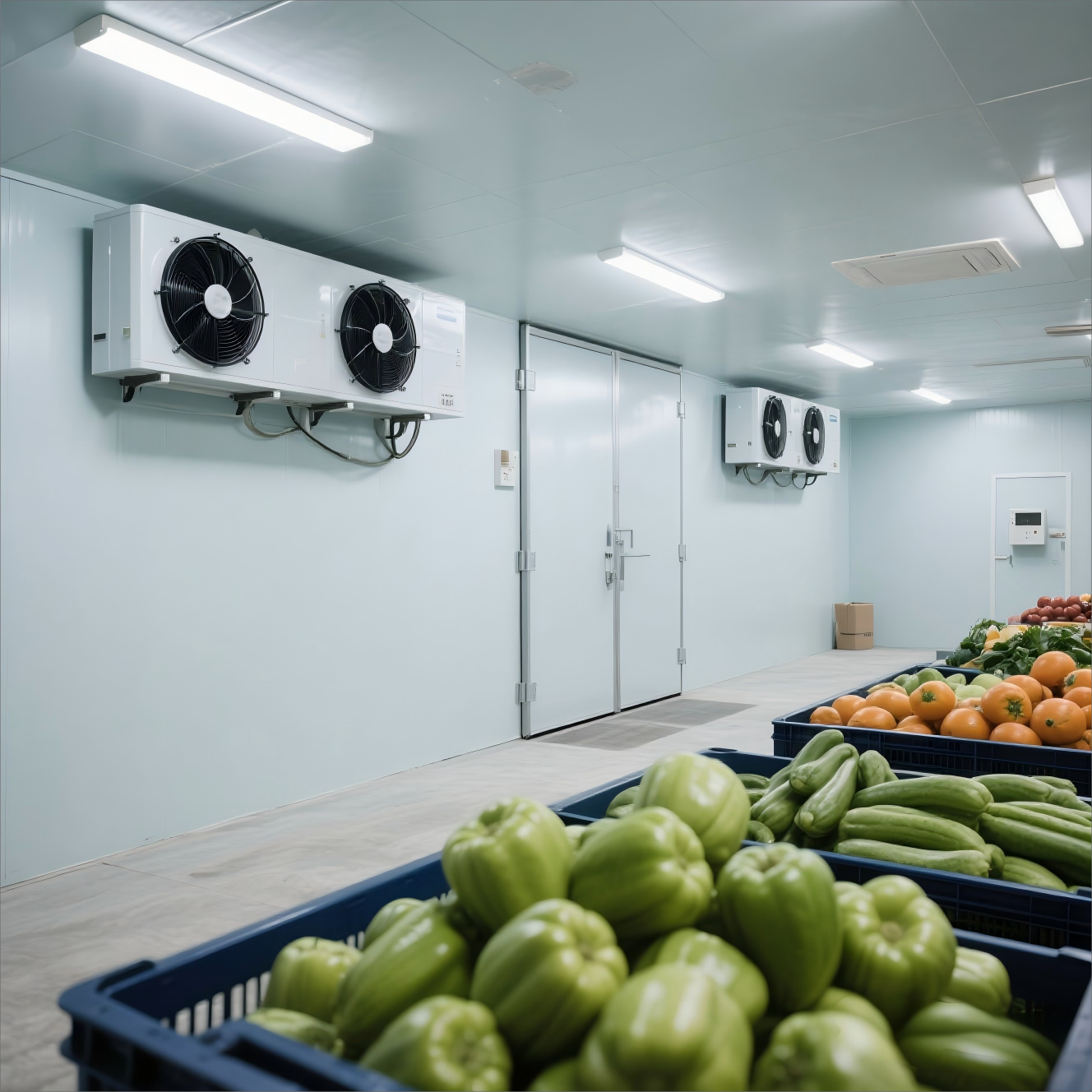Optimizing Temperature and Humidity for Produce Preservation
Varietal-Specific Temperature Needs in Fruit and Vegetable Cold Rooms
Different produce types require precise temperature ranges to maintain quality. Leafy greens thrive near freezing (32°F), while root vegetables store best at 40–50°F. Tropical fruits like bananas are prone to chilling injury below 55°F, highlighting the need for compartmentalized storage in mixed-load facilities.
Preventing Chilling Injury with Precise Temperature Control
Fluctuations exceeding 2°F can cause cellular damage in cold-sensitive crops such as stone fruits and tomatoes, leading to surface pitting and accelerated decay. Modern refrigeration systems using cascade cooling maintain ±0.5°F accuracy, ensuring thermal stability critical for preserving texture and shelf life.
Ideal Relative Humidity Levels for Different Fruits and Vegetables
Humidity requirements vary significantly across produce types. Cucumbers and leafy greens need high humidity (90–95% RH) to prevent wilting, whereas onions and garlic require drier conditions (65–70% RH) to avoid mold. These differences necessitate separate chambers or localized humidity control within shared cold rooms.
Technologies for Stable Humidity and Dynamic Sensor-Based Adjustments
Advanced cold rooms integrate hygrothermal sensors with automated misting and ventilation systems, maintaining humidity within ±3% of target levels. Real-time climate adaptation, as demonstrated in the 2025 Potato Storage Study, has reduced waste by 18%. Additionally, CFD modeling optimizes airflow to eliminate microclimates in bulk storage, enhancing uniformity and product integrity.
Efficient Cold Room Layout and Space Utilization Strategies

Designing Functional Floor Plans for Maximum Storage and Workflow Efficiency
Cold rooms work best when they strike a balance between how much stuff can be stored vertically versus how easy it is to move around inside. Putting in those vertical racks that fit standard produce boxes actually saves a lot of space, maybe even 40% more than just stacking everything on one level. The layout matters too. Cold rooms with U-shaped aisles or ones where the aisles run parallel cut down on how far forklifts have to go, which means workers get things done faster throughout the day. Safety is another big concern, so many facilities install modular walls to keep sensitive items like leafy greens and berries away from fruits that give off ethylene gas, such as apples and tomatoes. Nobody wants their delicate greens turning brown because they're sitting next to something that's basically a fruit version of a smoke bomb.
Calculating Storage Capacity and Throughput for Fruit and Vegetable Cold Rooms
Effective planning relies on three key metrics:
- Peak inventory volume (cubic meters) during harvest periods
- Daily turnover rate (15–25% for stone fruits vs. 5–10% for root vegetables)
- Handling time per pallet (ideally under 2 minutes to minimize temperature excursions)
For example, a 500 m³ cold room storing bell peppers at 7°C with a 15-day shelf life should have one loading dock per 150 m³ to support 20 pallets/hour while maintaining USDA-recommended 75% humidity.
Integrating Pre-Cooling Zones and Handling Areas into Cold Room Design
Cooling rooms next to the loading areas help get rid of field heat before fruits and veggies go into cold storage. This cuts down on how much energy is needed later while keeping things fresh longer. There are also these buffer spaces about 1.5 to 2 meters wide between different temperature areas which stop warm air mixing when products move around. For stuff that goes bad fast like asparagus and mushrooms, automated gates send them straight to quick chill zones right after they arrive. Getting those perishables cooled down fast makes all the difference in maintaining quality through the whole storage process.
Insulation, Energy Efficiency, and Long-Term Performance
Proper insulation is essential for minimizing energy consumption and maintaining consistent storage conditions. Research indicates that a 12°F temperature fluctuation can increase annual energy costs by $740 (Ponemon 2023), emphasizing the importance of high-performance materials and design.
Material Selection and Thickness Optimization for Thermal Efficiency
Cold rooms typically use polyurethane foam or mineral wool because these materials conduct very little heat, around 0.023 W/m·K or less. Recent studies from 2024 suggest that wall thickness between 150 to 200mm works best for most temperate regions. This extra layer cuts down on heat moving through the walls by about two thirds when compared with thinner 100mm panels. Expanded polystyrene (EPS) isn't recommended though since it tends to soak up moisture over time. We've seen cases where EPS breaks down about forty percent quicker in places with lots of humidity, making it a poor choice for cold storage applications where damp conditions are common.
Balancing Insulation Cost vs. Performance in Cold Room Construction
| Factor | Cost Premium | Energy Savings |
|---|---|---|
| 200mm PIR panels | 18% | 22% |
| Vapor barrier upgrades | 9% | 15% |
Lifecycle modeling shows these upgrades break even within 3–5 years through reduced refrigeration demand. Hybrid designs—such as aerogel-enhanced door seals paired with standard wall insulation—cut initial costs by 14% while retaining 95% of thermal efficiency.
Energy Savings and Quality Preservation Through Smart Insulation Design
Cold storage facilities can boost their energy efficiency quite a bit when they install continuous insulation that cuts off those pesky thermal bridges. Some studies indicate around a 19% improvement in efficiency with this method alone. Things get even better when paired with closed cell foam insulation and smart moisture sensors. These combinations help keep humidity levels under control, which means less spoilage for stored products. The numbers tell the story pretty well too – roughly 8% less product loss each year when humidity stays below 85% relative humidity. Looking ahead, there's some exciting developments happening with new phase change materials being worked into wall panels. Early tests suggest these could really help shift those expensive peak cooling demands away from times when electricity costs hit their highest points.
Key findings from recent thermal insulation studies confirm that optimizing insulation thickness delivers the highest cost-effective sustainability return, while lifecycle cost analyses show payback periods under 4 years for premium insulation in high-usage facilities.
Integrating Cold Chain Practices for Shelf Life and Food Safety
The Role of Pre-Cooling in Minimizing Post-Harvest Losses
Getting rid of field heat quickly makes all the difference when it comes to keeping produce fresh. Just think about what happens without proper pre-cooling: berries and leafy greens start losing between 30 to 50 percent of their shelf life right after harvest if they sit around too long. The vacuum cooling systems work wonders here, cutting down core temperatures at about three times the speed of regular air cooling methods. What's even better? These systems don't dry out the produce while doing this, which means sensitive items like asparagus and broccoli stay fresh on store shelves for nearly 18 extra days compared to traditional approaches. For farmers and distributors dealing with perishable goods, this kind of technology represents a game changer in reducing waste and maintaining quality throughout the supply chain.
Seamless Cold Chain Integration from Storage to Transportation
A robust cold chain depends on synchronization between cold rooms, refrigerated transport, and distribution hubs. Critical integration points include:
- Temperature-controlled dock seals (operational from -25°C to +5°C)
- Automated loading/unloading systems (90% faster than manual handling)
- Real-time GPS tracking with ±0.3°C accuracy
- Cross-dock facilities with 48-hour emergency storage capacity
Top-tier operations maintain temperature variation under 1°C across all stages, reducing microbial growth risk by 76% compared to fragmented systems (Ponemon Institute 2024).
Monitoring Systems and Automation for Food Safety and Shelf Life Extension
Today's cold storage facilities rely on internet connected sensors to track all sorts of factors inside the room. We're talking about things like ethylene gas buildup, carbon dioxide readings, how fast air is moving around, and plenty more besides. Some pretty smart computer programs can now guess how long fruits and veggies will stay fresh with about 94 percent accuracy. These systems work by comparing what's happening right now with past data on how different foods spoil over time. The vents in these rooms automatically change the airflow settings roughly every twelve minutes when someone opens a door or adds new boxes of produce. This helps maintain consistent temperature zones even when multiple types of perishables are stored together, which ultimately keeps everything safer for longer periods.
FAQ
What are the ideal temperature ranges for storing different types of produce?
Leafy greens thrive near freezing (32°F), root vegetables are best stored at 40–50°F, while tropical fruits like bananas require temperatures above 55°F to avoid chilling injury.
How does humidity affect produce storage?
Humidity levels are crucial as they vary across produce types. High humidity (90–95% RH) is necessary for cucumbers and leafy greens, while drier conditions (65–70% RH) are better for onions and garlic to prevent wilting or mold.
What is the role of pre-cooling in cold storage?
Pre-cooling removes field heat, increasing the shelf life of sensitive produce like berries and leafy greens, reducing wastage, and maintaining quality.

